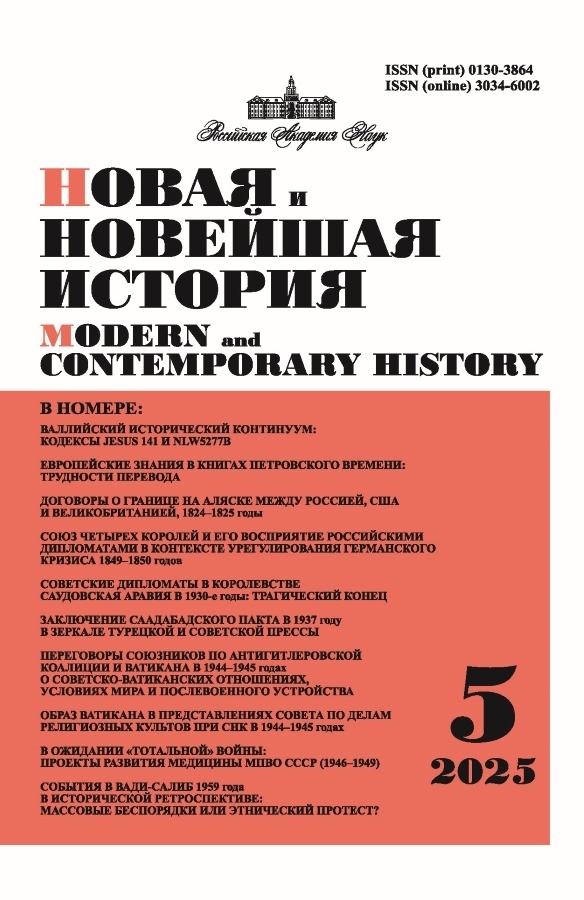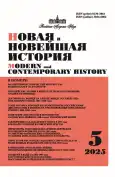Caucasian Viceroy and Regional Elites, 1845–1854: Patronage and Arbitration
- Authors: Urushadze A.T.1
-
Affiliations:
- European University at St. Petersburg
- Issue: No 5 (2025)
- Pages: 121-133
- Section: IMPERIAL ELITES AND THE PROSPECT OF “DECENTRALISATION”
- URL: https://gynecology.orscience.ru/0130-3864/article/view/693046
- DOI: https://doi.org/10.31857/S0130386425050098
- ID: 693046
Cite item
Abstract
This article examines the mechanisms of interaction between Prince Mikhail Vorontsov, the first Caucasian Viceroy, and the regional elites of Transcaucasia between 1845 and 1854. It analyses the imperial strategy, which combined patronage – through awards, appointments, and personal connections – with the Viceroy’s arbitration in disputes between different elite groups and/or the Russian administration. The study focuses on Vorontsov’s relations with three principal elite groups: the Georgian nobility, the Armenian merchant class, and the Muslim aristocracy. It demonstrates that the Viceroy pursued a flexible ethnopolitical strategy, accommodating the interests of these groups while managing their competition with one another. Patronage of influential aristocratic families and leading entrepreneurs formed an important part of his policy, as illustrated by the Georgian princely family of Orbeliani and the prominent Armenian merchant Ivan Mirzoev. The research is based on an extensive range of archival materials, including documents from the Central Historical Archives of Georgia that are introduced here for the first time. The article argues that Vorontsov’s approach contributed to the temporary stabilisation of the region, though its long-term effectiveness was limited. It challenges the explanatory weight given in existing historiography to the concepts of the “colonial elite” and “middlemen”. Vorontsov’s policy sought the full integration of regional elites into the wider social space of the Russian Empire, with many members of the traditional Transcaucasian aristocracy achieving distinguished careers in the imperial centre. The evidence suggests that the role of “intermediaries” was not decisive, their functions being largely confined to maintaining the technical operation of imperial administrative institutions.
About the authors
A. T. Urushadze
European University at St. Petersburg
Author for correspondence.
Email: aurushadze@eu.spb.ru
Saint-Petersburg, Russia
References
- Anchabadze Yu.D., Volkova N.G. Old Tbilisi. The city and its inhabitants in the 19th century. Moscow, 1990. (In Russ.)
- Bliev M.M., Degoev V.V. Modern bourgeois historiography of Russia’s policy in the Caucasus and Central Asia in the 19th century // Questions of history. 1988. № 4. Р. 37–53. (In Russ.)
- Ethnic elites in Russian National politics / ed. V.V. Trepavlov. Moscow; Saint-Petersburg, 2017. (In Russ.)
- Gogitidze M. Georgian generals (1699–1921). Biographical reference book. Kiev, 2001. (In Russ.)
- Hodarkovskii M. Bitter choices: Loyalty and betrayal in the Russian conquest of the North Caucasus. Moscow, 2016. (In Russ.)
- Kaznacheev A.I. Private letters to Count M.S. Vorontsov, 1828–1837 / comp. A.K. Afanasyev. Moscow, 2015. (In Russ.)
- Konkin D.V. Graf M.S. Vorontsov and the ransom issue in the Crimea // Materials on archeology, history and ethnography ofTavria.2010. Iss. XVI. Р. 488–518. (In Russ.)
- Lapin V.V. Russia’s army in the Caucasian War of the 18th–19th centuries. Saint-Petersburg, 2008. (In Russ.)
- Lazaryan S.S. The Caucasus under the administration of Prince M.S. Vorontsov (1844–1855). Moscow, 2022. (In Russ.)
- Lukoyanov I.V. “Not to fall behind the powers...”. Russia in the Far East in the late 19th – early 20th centuries. Saint-Petersburg, 2008. (In Russ.)
- Matsuzato K. Governor-generalships in the Russian Empire: From ethnic to spatial approach // The New Imperial History of the post-Soviet Space / eds I.V. Gerasimova, S.V. Glebova. A.P. Kaplunovskogo, M.B. Mogil’ner, A.M. Semenova. Kazan, 2004. Р. 431–432. (In Russ.)
- Osterhammel Y. The transformation of the world: A history of the 19th century. T. II. Moscow, 2024. (In Russ.)
- Rybakov A.L. In the “domain of Caesar”: Problems of status and structure of the Georgian Orthodox Church after the abolition of autocephaly (first half of the 19th century) // Denomination, Empire, nation: Religion and the problem of diversity from the history of the post-Soviet space. Moscow, 2012. Р. 274–315. (In Russ.)
- Sartori P., Shablei P. Empire’s experiments: Adat, sharia and knowledge production in the Kazakh steppe. Moscow, 2019. (In Russ.)
- The North Caucasus as part of the Russian Empire. Moscow, 2007. (In Russ.)
- The Russian Empire and the Crimea / eds D.V. Konkina, N.V. Khrapunova. Simferopol, 2010. P. 121–164. (In Russ.)
- Udovik V.A. Vorontsov. Moscow, 2004. (In Russ.)
- Vardosanidze V. Tiflis, 1914–1921. Dramatic pages from the biography of a two-faced Janus // Cities of the Empireduring the Great War and the Revolution. Collection of articles / edsA.I. Miller, D. Cherny. Saint-Petersburg, 2017. Р. 410–473. (In Russ.)
- Volkhonskii M.A. The policy of Alexander III’s government on supporting the Georgian nobility: Debts and estates // Quaestio Rossica. 2022. T. 10. № 3. Р. 903–918. (In Russ.)
- Zakharova O.Yu. Field Marshal His Serene Highness Prince M.S. Vorontsov. Knight of the Russian Empire. Moscow, 2001. (In Russ.)
- Rhinelander A.L.H. Prince Michael Vorontsov. Viceroy to the Tsar. Montreal, 1990.
Supplementary files








